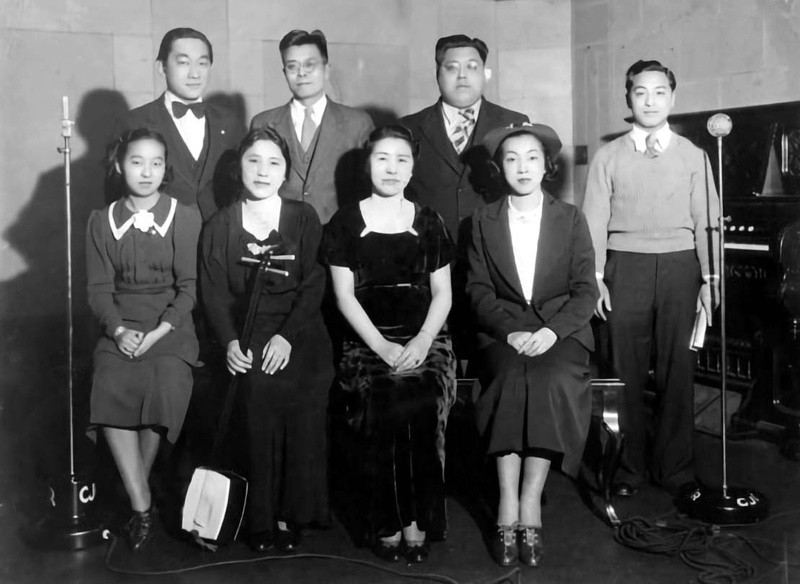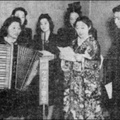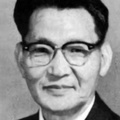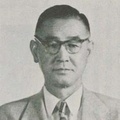In the second installment, we will introduce Shinkosha's "Japanese Song Broadcast," a pioneer in Japanese language broadcasting.
In March 1935, a broadcasting station approached the Canadian Japanese Society with a request to broadcast a Japanese program. The Society was not able to organize programs or collect advertisements, so they chose Kaizo Tsuyuki (from Kanagawa Prefecture), who had experience. Although it says "experienced," this does not mean that Tsuyuki had experience in radio broadcasting. Tsuyuki established a film touring company called "Shinkosha" and imported silent film from Japan, which he took to Canada, as well as to places across the border like Seattle, Washington, and Portland, Oregon, where he held film screenings in towns with Japanese residents. He may have collected advertisements in addition to admission fees for screenings. Tsuyuki also demonstrated his talent as a film narrator (benshi). His voice, honed as a benshi, was perfect for an announcer.
Thus, Shinkosha began broadcasting Japanese language once a month from CJOR in June 1935. CJOR had a transmitting power of 500 watts and was the most powerful station in Vancouver at the time.
Program Contents
The first program was broadcast at 9 p.m. on June 16, 1935. As it happened, the Kaiwo Maru, a training ship belonging to the Japan Nautical Training School, was in Vancouver, so a program was put together to welcome the Kaiwo Maru. Greetings from the consul, the Japanese chairman, Captain Kichitaro Miyamoto, and a chorus of the crew were all broadcast over the airwaves on this memorable first broadcast.
The second broadcast took place on July 21st, and featured live performances of Nagauta "Tsurukame," kouta "Tojin Okichi," and folk song "Okesa Bushi." The program "obtained unexpectedly good results, which gave us strength" (Continent Daily News, August 5th, 1935), and so the program was scheduled for a third broadcast.
December 1, 1935 was a special feature on Steveston Village, and Nakatsu Teruo, Samukawa Miyo, Nishi Yuriko, Sasaki Yakko, Wakida Chiyo, and Kono Masako, all recommended by Mio Tomekichi of the village's Sakura-kai, who was requested by Tsuyuki, stood in front of the microphone. One of the guests expressed their joy, saying, "What a joy, what a blessing," because if they had stayed in Japan, they would never have imagined appearing on a broadcast, and would never have listened to the radio. Another person expressed their hopes, saying, "I wonder if my voice will reach Japan" (Continent Daily News, December 4, 1935).
This episode was well-received, and on another day, a program was aired featuring music lovers from areas with large Japanese populations, such as Fairview, New Westminster, and Lion Island.
Records were rarely played on this program, called "Japanese Song Broadcasting," and it continued to feature live performances by local musicians. A notable feature of the performers was the large number of female proprietresses and geisha from Japanese-run restaurants. For Japanese music that was popular at the time, such as kouta, hanuta, tokiwazu, and dodoitsu, veteran performers from Chidoritei (Tamako), Kintaro (Emiko, Fumiko), Tamagawa (Yuriko), Rakurakutei (Mary, Hezuru, Tamae), Hinode (Yaeko), Hinomarutei (Fumiko), Fukusuketei (Fumiko, Mieko), and Daruma-tei (Yaeko) were invited to perform. In addition, a total of more than 80 performers, including second-generation musicians such as Kumano Yoshio (harmonica), Kumano Mitsunobu (vocals), Nakamura Tetsu (vocals), Ide Ritsuko (piano and vocals), Takeuchi Aiko (vocals), and Sakai Iwaichi (harmonica and piano), enlivened the program.
Although it was called "Japanese Song Broadcasting," other programs were also planned. Other popular programs included comic storytelling such as "Kachiguri-san" (Yanagiya Yanosuke), Gidayu "The Night Attack of the Horikawa River at the Imperial Palace, from the Beginning to the End of the Act on the Envoy of Benkei" (Tsuruzawa Katsuito), and Chikuzen Biwa "Crossing the Lake" (Kawano Yukino). Other popular programs included reciting poems such as "Entering Taiwan" and "Kawanakajima" (Ikeda Chuhei), a hobby lecture "The Virgin Mary and Japanese Women" (Matsumoto Unshu), a lecture on "Japanese Health" (Ishii Yasushi, Consul), a lecture on "Cautions for the Summer" (Japanese Health Consultation Center), and a radio drama "Chushingura Act 5, The Scene of the Encounter with Yagoro Kanpei" (Nishizawa Banka and Tachibana Ka). In a rare episode, the rakugo performer Suzugi Yonewaka, who was in Vancouver on his North American tour, made a live appearance on the broadcast on November 11, 1935, greeting the audience and performing a Naniwabushi song.
Initially, the program was broadcast once or twice a month, but after August 1936, it became an irregular program, and continued in October 1936, April 1937, and finally, on May 10, 1937, the program previews for the Japanese Song Broadcasting Program were no longer broadcast. This was probably the last broadcast. The program was broadcast 20 times in total.
Program staff
Finally, let's summarize the people involved in the program. Kaizo Tsuyuki was in charge of the Japanese announcements. From the sixth episode (November 1935), English announcements were introduced, and Nakamura Hiroshi, who played for the Vancouver Asahi baseball team, appeared. From the seventh episode onwards, he was replaced by his younger brother, Nakamura Tetsu (Sally). From the 17th episode (August 1936), singer Ide Ritsuko (Lily) joined as the female English announcer.
By the way, the Japanese Cultural Center and Museum has a photo of the program (above). From the top left, Nakamura Tetsu, Tsuyuki Kaizo, Kumano Mitsunobu, Kumano Yoshio, and from the bottom left, Terakita Fujie, Rakurakutei Mary (presumed), Rakurakutei Hezuru (presumed), and Ide Ritsuko (presumed), and it is thought to be a commemorative photo of the farewell program for Mary on April 8, 1937.
*This article is reprinted from the monthly magazine " Freezer " (March 2022 issue).
© 2023 Tetsuya Hirahara







